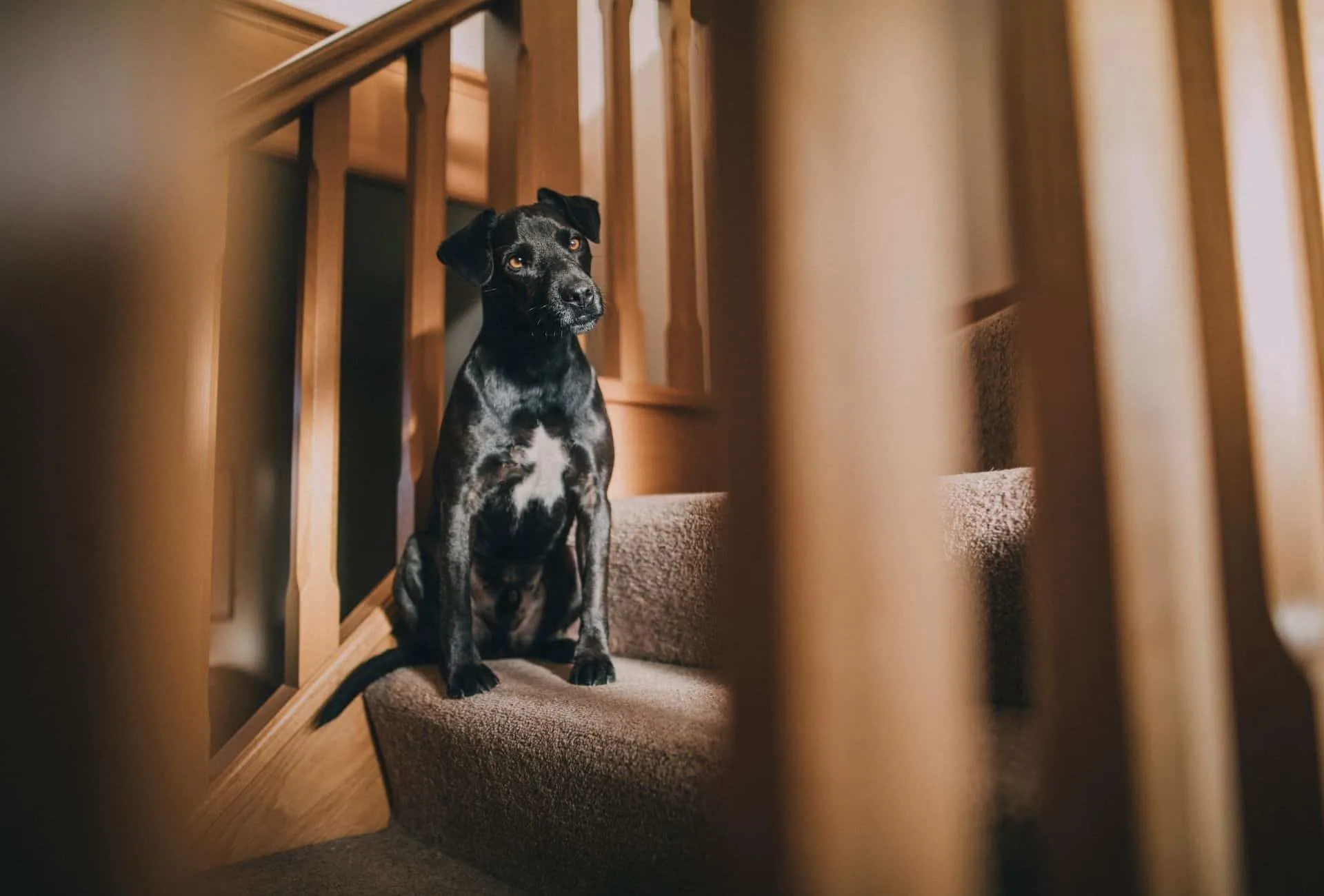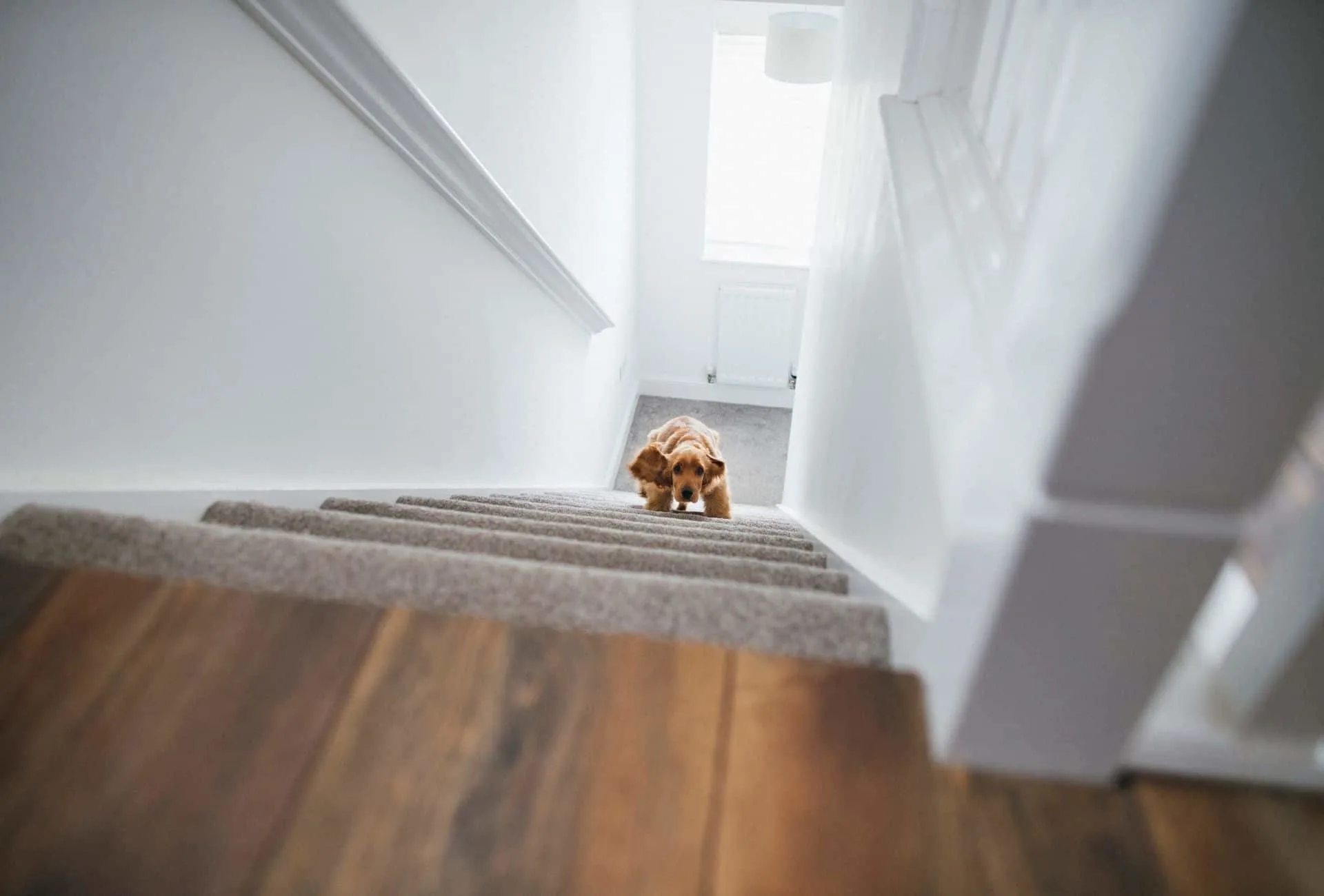Stairs are a part of many people’s lives and while we don’t notice them anymore on a daily basis, they can be a huge obstacle for certain breeds and young dogs.
You may be worried about all the gaps your puppy could fall through and what it would do to his joints if he had to walk up and down them several times a day.
Imagine your 6-pound puppy taking a continuous tumble, like some sort of football, down your stairs.
What would you do, and how could you have prevented this?
Can Your Dog Safely Walk Up Stairs?
This is a general question with different answers depending on the dog and the type of stairs.
We, humans, have countless different types of stairs we use, and some dogs will have a much harder time ‘climbing’ these stairs than others.
An adult human thinks of a standard set of carpeted stairs, the type most would have in the standard home, as something we ‘walk’ up.
These carpeted stairs are normally soft and created for the human leg in mind, enabling us to simply ‘step’ up them.
Escalating a set of stairs is very natural for us, but not always natural for a dog.
Whereas we simply ‘step’ up these stairs, dogs do something much closer to actual climbing.
Exited dogs sometimes try to run up these stairs, which can easily create a slippery hazard in the case of outside decks.
This can be especially hazardous during the winter if your deck is built on a second level.
Normally dogs won’t slip and fall (four legs provide extra traction), as long as these stairs aren’t wet and there is a railing on each side.
They can bang their legs against the steps, however, which can cause injury.
Older dogs tend to endure joint issues caused by eroding tissue (i.e. arthritis), which can make climbing, not ‘walking up’, stairs very uncomfortable.

Are Stairs Bad for Puppy Joints?
Again, this depends on the type of stairs and the age, as well as breed, of the puppy.
Very young puppies aren’t yet fully coordinated and could easily fall down any set of stairs.
Hip dysplasia is a condition occurring when the ball and socket joint of the hip doesn’t articulate like it should, almost always either leading to or contributing toward secondary conditions (i.e. arthritis).
Certain larger breeds (Rottweiler, German Shepherd, etc.) are especially prone to developing hip dysplasia, and studies have shown being forced to climb stairs can contribute.
Stairs aren’t recommended for larger breed puppies. Instead, consider introducing a ramp.
At What Age Can a Dog Climb Stairs?
Twelve weeks (3 months) is a time you might introduce stairs as a part of your socialization routine.
Because of an increased risk of joint-related developmental issues in larger breeds, you might want to wait a little bit longer.
You want to wait until your puppy is large enough to safely navigate these steps, and coordinated enough not to simply slip and tumble down them.
Remember, stairs are designed for human legs, and may require some actual training on your part!
Should I Let My Puppy Go Up and Down Stairs?
This depends on the type of stairs, the condition they provide, and the age of your puppy.
Sometimes your puppy shouldn’t be climbing stairs.
Is your puppy so small he literally has to jump from step to step?
Puppies tend to become easily excitable and could become injured in this type of situation.
Are these stairs made of a harder material like wood or metal?
Your puppy should avoid stairs if there is no softer covering or nothing to provide any kind of traction.
Are the stairs covered in snow, ice, or wet? Puppies aren’t always coordinated, and this could even create a hazard for fully grown dogs.
What breed is your puppy?
Consider replacing the stairs or simply adding a ramp if you care for a breed more prone to joint-related problems, like Great Danes or Retrievers.
How Do I Get My Puppy to Go Down Stairs?
This is all about building confidence, just like any agility trick.
Most dogs can easily walk across a balance beam (agility dog walk) taller than a human, or up a six-foot ramp, but they need to convince themselves of these capabilities.
Training a dog to navigate stairs won’t take long at all (assuming they are appropriately aged), as long as you use the correct training approach.
Carefully, slowly lure your puppy down these stairs (using treats), one at a time with your pup by your side.
Offer plenty of praise and enthusiastic reinforcement, showing your pup this is a fun activity.
Your puppy will climb these stairs on his or her own very soon.
Your puppy wants to be able to get around the house with you, but stairs built for humans can seem unnatural and frightening at first.
You can relate this to the initial fear of riding (and falling from) a two-wheeled bike without training wheels you had as a child, and how effortless it seems now as an adult.
Why Are Dogs Afraid of Stairs?
A better question would be ‘Why are dogs afraid of heights’?
Why are humans afraid of tall ladders or rooftops, even though there is no rational risk involved as long as they are careful?
Imagine standing in a skyscraper with a novelty floor made of glass (these do exist in several upscale buildings).
You can see an entire city hundreds of feet below you, and the idea of falling is terrifying.
There is absolutely no chance for survival at this height.
Rationally, you know the architects spent millions and unfathomable resources ensuring your safety.
You could probably drop a 300-pound metal barbell on this flooring and it would barely crack, but your subconscious instinct is to feel fear.
Dogs are intelligent creatures and fear the unknown.
They fear what they haven’t yet experienced because it might just hurt them.
Your dog might be afraid of stairs for the same reason dogs are initially afraid of six-foot-tall dog walks.
He is afraid of slipping, falling, and hurting himself.
If your dog has fallen and gotten hurt, he’s probably learned to fear the stairs from that experience.

What Should I Do if my Dog Falls Down the Stairs?
If your dog falls down the stairs, your first step should be to ensure the little one wasn’t injured.
If your dog injured himself, veterinary care might be required (but that is a different topic altogether).
Dogs aren’t always as perceptive to pain as humans and tend to power through injuries if they are excited, failing to realize any pain until they have calmed.
Check your puppy to ensure nothing is injured, even though he might seem like his normal, enthusiastic self.
Let’s assume your dog is just a little startled from the fall, and not actually injured.
Whereas the tumble didn’t break, dislocate or tear anything, it still didn’t feel good and your puppy is now frightened of the stairs.
Now your focus should shift to a behavioral perspective.
Don’t ‘baby’ your pet, but rather try to make it seem like everything is normal and there is nothing to worry about.
That mothering instinct driving you to want to cuddle your pet could actually make it seem to him or her like the situation is worse.
You’ll have to slowly, gradually train your dog to walk up and down the steps, building confidence as you go.
Imagine you are training your dog to run (but walk, not run) up that agility ramp.
The ‘lure and reward’ technique couldn’t be better for this type of training.
Simply guide your puppy up one step at a time, his nose following that treat in your hand like some invisible hook is attached.
Once your dog climbs a step or two, reward him.
Gradually increase the difficulty, those two steps before rewarding turning into four, eight, and eventually the entire stairwell.
Dog training is usually made easier when the handler creates a sort of game, incorporating plenty of enthusiastic encouragement, but you don’t want your dog to become excited and re-injure himself.
Instead of encouraging speed, focus on slow and careful movements.
Help! My Dog Fell Off the Side of the Stairs!
This is a scenario you would absolutely want to prevent from ever happening, as opposed to attempting to treat a fall.
Though steps lacking side rails might hold some artistic value to us humans, depending on the setup of your home, they create an enormous hazard for pets.
The largest concern for any medical professional dealing with any human fall-related trauma is a spinal injury first, head trauma very close second.
Fall victims have to be moved very carefully by emergency responders in order to prevent any paralysis.
What If My Pet Is Unconscious?
In our dog’s case, emergency responders aren’t going to race to your home and evac the pup to a nearby hospital.
If the situation allows for the possibility of moving an injured pet, be careful to prevent your pet’s head/neck from moving while gently placing him in a vehicle.
Keep in mind, dogs suffering from a head injury can present with an altered mental status and become aggressive.
Consider contacting an emergency veterinarian before taking any action on your own.
Are Ramps Better?
For aging dogs coping with arthritic joints, overweight or larger breeds prone to developmental issues, ramps are always better.
In fact, ramps would always be better for any dog since they are more natural for them and don’t require the same form of work to transverse.
Unfortunately, installing a ramp in a home to replace a stairwell isn’t always easy or inexpensive.
Most of the time, it simply isn’t very feasible.
Make sure the railings offer enough side protection while ensuring some type of soft, cushioned material is covering your steps and providing traction.
In the end, all things considered, a ramp is more ‘dog friendly’ than any stairs.
Disclaimer: This blog post does not substitute veterinary attention and does not intend to do so. I am not a veterinarian or pet nutritionist. If your dog shows any sign of illness, call your vet.